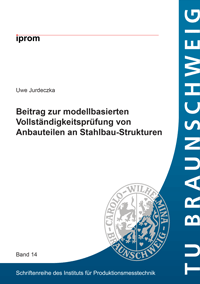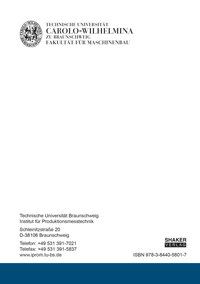
Shop : Details
Shop
Details
48,80 €ISBN 978-3-8440-5801-7Softcover162 pages45 figures240 g21 x 14,8 cmGermanThesis
March 2018
Uwe Jurdeczka
Beitrag zur modellbasierten Vollständigkeitsprüfung von Anbauteilen an Stahlbau-Strukturen
Die Vollständigkeitsprüfung an Stahlbaustrukturen mit mehreren hundert Anbauteilen (wie zum Beispiel Wagenkästen/Karosserien für Schienenfahrzeuge) ist eine Herausforderung. Diese Prüfaufgabe kann nunmehr mit den Ergebnissen dieser Arbeit als eine gerätegestützte Prüfung mit weitgehend automatisiertem Prüfentscheid dargestellt werden. Dazu erfolgen die Aufnahme des Ist-Zustandes mit einem 3D-Scanner und die anschließende Auswertung durch einen im Rahmen dieser Arbeit entwickelten Algorithmus. Es gelingt, mit dem Einsatz von 3D-Scannern ausreichend umfangreiche Informationen über die Ist-Konfiguration der zu prüfenden Stahlbaustruktur zu gewinnen. Mittels eines angepassten und neu entwickelten Algorithmus wird das jeweilige 3D-Modell als Soll-Zustand mit dem Ist-Zustand überlagert. Aus dieser Überlagerung werden Differenzbilder gewonnen. Diese Differenzbilder zeigen eventuelle Abweichungen und Fehlteile an, mindestens jedenfalls die suspekten Stellen für eine nachfolgende manuelle Nachprüfung. Damit lassen sich die Nachteile der bisher praktizierten ausschließlich manuellen Vollständigkeitsprüfung, nämlich Ermüdung und Geschwindigkeit der Prüfer, weitgehend umgehen.
Completeness checking of constructional steel structures with several hundred mounted parts (such as car body shells/chassis for rail vehicles, for example) represents a great challenge. Based on the results of this study, that task can now be presented as instrument-based testing with a largely automated test report. For this purpose, the actual state is captured by a 3D scanner, with the subsequent evaluation being performed by an algorithm developed during this study. The use of 3D scanners allows to obtain sufficiently comprehensive information about the actual configuration (as-is state) of the constructional steel structure to be checked. By using an adapted and newly developed algorithm, the respective 3D model as the target state is superimposed over the actual state, which results in difference figures. These difference figures show possible deviations and missing parts, at least, however, suspect points to be then checked again manually. Thus, the disadvantages of the exclusively manual completeness checking practiced so far, i.e. tiredness and slowness of the inspectors, can largely be avoided.
Completeness checking of constructional steel structures with several hundred mounted parts (such as car body shells/chassis for rail vehicles, for example) represents a great challenge. Based on the results of this study, that task can now be presented as instrument-based testing with a largely automated test report. For this purpose, the actual state is captured by a 3D scanner, with the subsequent evaluation being performed by an algorithm developed during this study. The use of 3D scanners allows to obtain sufficiently comprehensive information about the actual configuration (as-is state) of the constructional steel structure to be checked. By using an adapted and newly developed algorithm, the respective 3D model as the target state is superimposed over the actual state, which results in difference figures. These difference figures show possible deviations and missing parts, at least, however, suspect points to be then checked again manually. Thus, the disadvantages of the exclusively manual completeness checking practiced so far, i.e. tiredness and slowness of the inspectors, can largely be avoided.
Keywords: Stahlbaustrukturen; Vollständigkeitsprüfung; 3D-Laserscanner; Auswertealgorithmus; Differenzbilder; Constructional steel structures; completeness checking; 3D laser scanner; analyzing algorithm; difference figures
Schriftenreihe des Instituts für Produktionsmesstechnik
Edited by Prof. Dr.-Ing. Rainer Tutsch, Braunschweig
Volume 14
Export of bibliographic data
Shaker Verlag GmbH
Am Langen Graben 15a
52353 Düren
Germany
Am Langen Graben 15a
52353 Düren
Germany
Mon. - Thurs. 8:00 a.m. to 4:00 p.m.
Fri. 8:00 a.m. to 3:00 p.m.
Fri. 8:00 a.m. to 3:00 p.m.
Contact us. We will be happy to help you.



